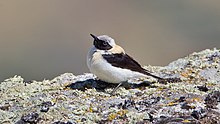Western black-eared wheatear
This article needs additional citations for verification. (December 2010) |
| Western black-eared wheatear | |
|---|---|

| |
| male | |
| Scientific classification | |
| Domain: | Eukaryota |
| Kingdom: | Animalia |
| Phylum: | Chordata |
| Class: | Aves |
| Order: | Passeriformes |
| Family: | Muscicapidae |
| Genus: | Oenanthe |
| Species: | O. hispanica
|
| Binomial name | |
| Oenanthe hispanica | |
| Synonyms | |
|
Motacilla hispanica Linnaeus, 1758 | |
The western black-eared wheatear (Oenanthe hispanica) is a
The breeding male has the forehead and crown white or nearly white, the mantle buff, and the wings blacker than those of the northern wheatear. The underparts are white tinged with buff. The back, upper tail coverts and most of the tail are white. A black mask extends from the ear coverts to the bill. The throat can be either black or white.
In autumn and winter the head and mantle are distinctly buff, as are the underparts (including the throat in non-black-throated individuals), but the buff varies in intensity. Except for the central pair, the tail feathers are much whiter than in the northern wheatear, the white on the inner web often extending to the tip.
The female is a browner bird, but has the characteristic white lower back, and her seasonal changes are less marked.
The male western black-eared wheatear can be distinguished from the male eastern black-eared wheatear by its more buff-tinged upperparts, giving it a less distinctly black-and-white appearance than the latter species, as well as having the black of the mask stopping at the base of the bill rather than extending slightly above. Black-throated individuals of this species have less black on the throat and face than on the eastern birds, and the black generally terminates less abruptly. Females of this species differ from their eastern counterparts in being warmer brown overall.
Taxonomy
In 1743 the English naturalist
The genus name Oenanthe is derived from the
References
- . Retrieved 13 November 2021.
- ^ Edwards, George (1743). A Natural History of Uncommon Birds. Vol. Part 1. London: Printed for the author at the College of Physicians. p. 31, Plate 31.
- ^ Linnaeus, Carl (1758). Systema Naturae per regna tria naturae, secundum classes, ordines, genera, species, cum characteribus, differentiis, synonymis, locis (in Latin). Vol. 1 (10th ed.). Holmiae (Stockholm): Laurentii Salvii. p. 186.
- ISBN 978-1-4081-2501-4.
- ^ Vieillot, Louis Pierre (1883) [1816]. Saunders, Howard (ed.). Vieillot's Analyse d'une nouvelle ornithologie élémentaire (in French). London. p. 43.
{{cite book}}: CS1 maint: location missing publisher (link) - ^ Rasmussen, Pamela, eds. (July 2021). "Chats, Old World flycatchers". IOC World Bird List Version 11.2. International Ornithologists' Union. Retrieved 3 October 2021.
- PMID 30421480.
- ISBN 978-1-4081-2501-4.
- ^ "Wheatear". Oxford English Dictionary (Online ed.). Oxford University Press. (Subscription or participating institution membership required.)
Further reading
- Ullman, Magnus (2003). "Separation of Western and Eastern Black-eared Wheatear" (PDF). Dutch Birding. 25 (2): 77–97.
External links
- Black-eared Wheatear videos, photos & sounds on the Internet Bird Collection
- Ageing and sexing (PDF; 3.8 MB) by Javier Blasco-Zumeta & Gerd-Michael Heinze

